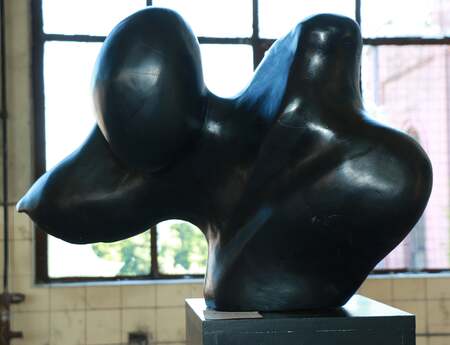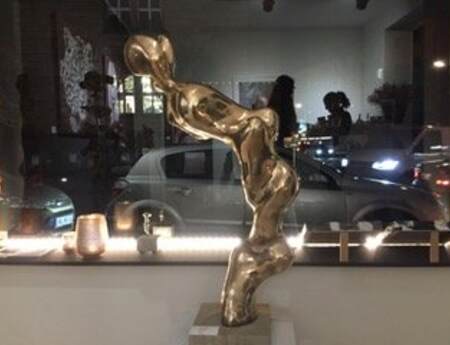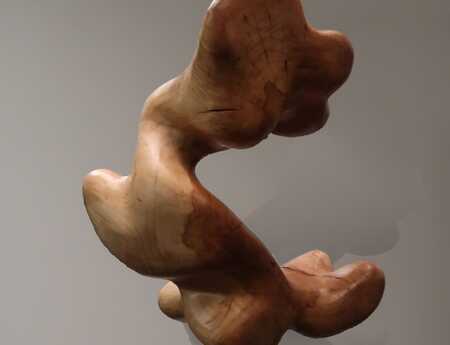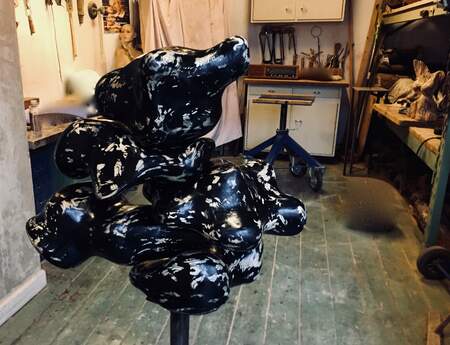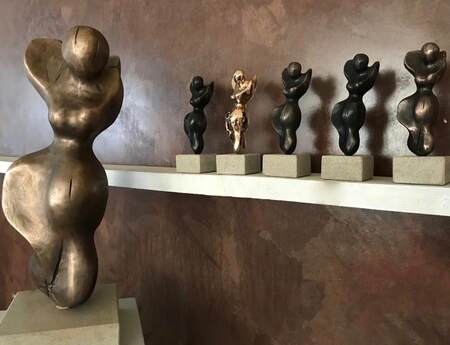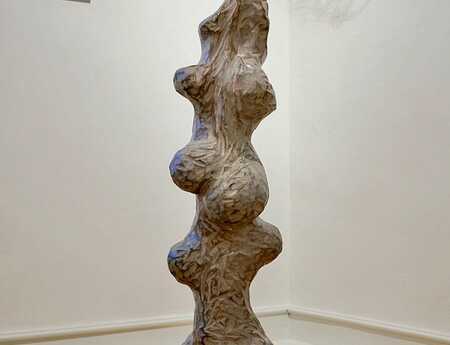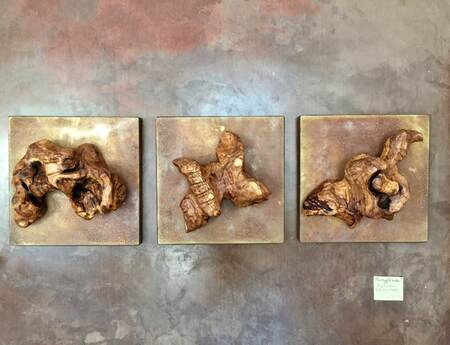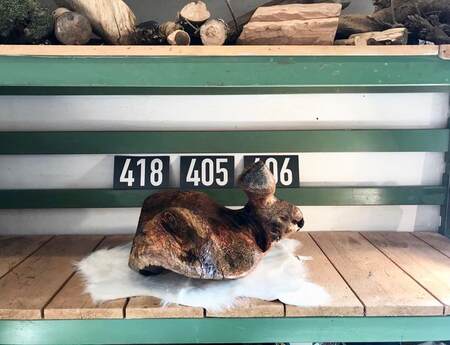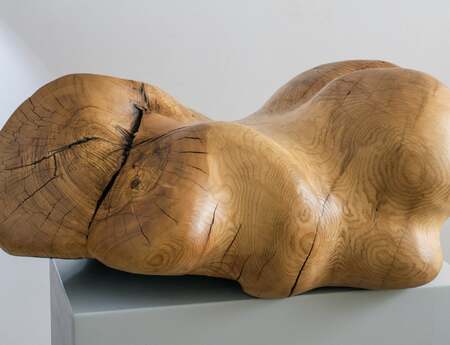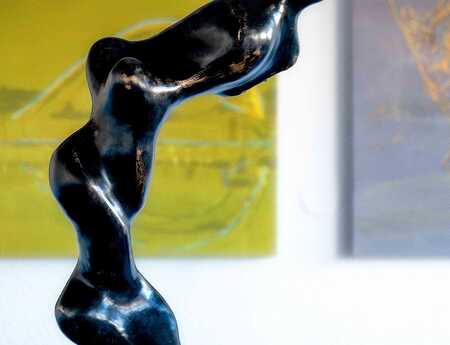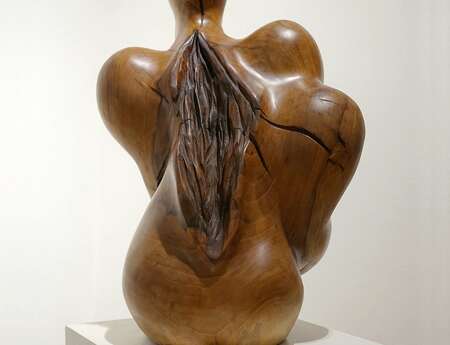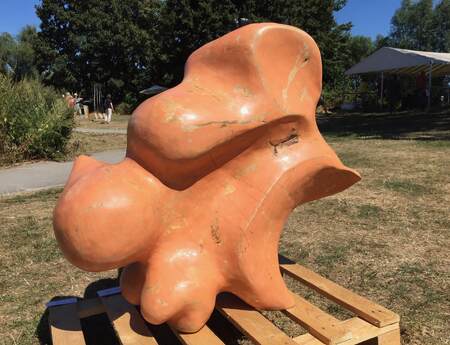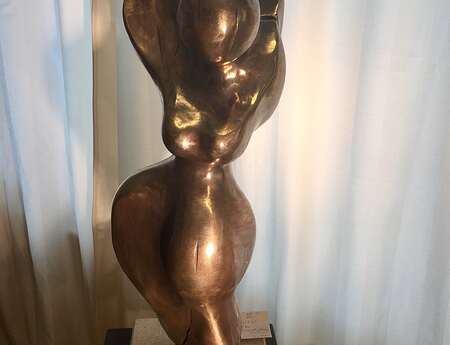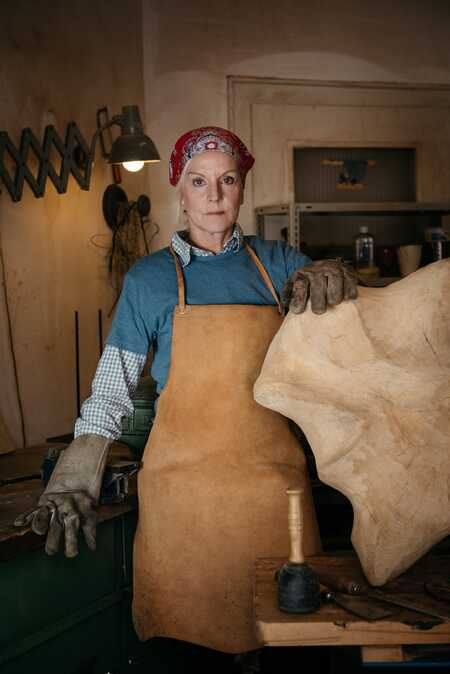
Germany
Pia Bohr
Pia Bohr | Sculptress
https://www.bohrskulpturen.de/ About coping with reality
My life as a musician Pia Lund spanned over 25 years, so I am very familiar with creative processes, from the idea to the realization. Within a band, creativity always means compromising and respecting hierarchies. As a sculptress, my name is Pia Bohr, I was forbidden to continue using the stage name Lund any further. I have been working professionally in the fine arts since 2000, also parallel to music, here I am completely free in my decisions and working processes up to the finished sculpture. I think my sculptural work is the continuation of my musical work, only with different means: Bohr's sculptures are created just as narrative and organic as Lund's compositions.
There is a famous quote by Hans Arp: “We don't copy, we build.” That is exactly what describes the work of a sculptor.
Sounding names, devastating scars
The three-dimensionality enables a great heterogeneity of the works, as well as a variety of visual impressions and interpretations. The formal language of Hans Arp or the distortions of Francis Bacon fascinated me from the start. My sculptures are also organic and show biomorphic forms, they move between figurativeness and abstraction, they are determined and indefinite at the same time – it is about the embodiment of energies and nature, materiality and invisibility work together. For me, sculpture is the medium for coping with reality, I try to integrate the real into art and consciously create new compositions. My wood and bronze sculptures bear resounding names and devastating scars, tell stories of love and suffering, are touching and soulful. The viewer recognizes corporealities, analogies from flora and fauna, the living, the changeable – the psychological potential of organic forms is immeasurable.
New perspectives
My backyard studio used to be part of the maternity ward of the clinics in Dortmund, Germany, babies were born here, now it's my sculptures that see the light of day. My work is very physical, I use chainsaws, special milling machines, but also chisels and mallets, and in the end the abrasive wool. I prefer heavy hardwoods such as fruit-nut-olive wood – because of their high density, the grain is particularly lively and beautiful. I can even create a perfect smoothness in the last step of the work with laborious manual labor, which immediately creates a feeling of wanting to touch in the viewer.
The process of seeing a sculpture in wood can be long and requires flexibility. The artistic work teaches such a thing wonderfully. Learning to see goes hand in hand with motivation, disappointment and happiness. It remains necessary to constantly question oneself and to develop further, this is how happiness arises, that is the freedom of art.
I had some of my sculptures cast as bronzes in a series. Here, too, I attach great importance to an aesthetically beautiful surface treatment and coloring – including the philosophical-artistic issues that the duplication and distribution of an artifact or the dealing with 3D technology and scalability entail. New technologies also mean the opening of new perspectives.
Released to be touched
My art is also a haptic art. For the visual arts, reality is usually only important insofar as it manifests itself in the optical image. When looking at a work of art, art historians and aesthetes start from the visual; the shape-forming ability of the haptic sense is not mentioned at all.
Buyers and collectors of my work build an emotional bond to their sculpture and keep saying: “I have to touch it at least once a day.” I also received an incredible response at an exhibition for the blind and disabled people.
In today's world with corona and digitization, a cultural change is taking place. The physical presence and the living get another, very important value. It would therefore be possible for me to allow one or two sculptures to be touched at exhibitions.
Pia Bohr | bohrskulpturen.de
Von der Bewältigung der Realität
Meine Lebensphase als Musikerin Pia Lund umfasste über 25 Jahre, daher bin ich mit kreativen Prozessen, von der Idee bis zur Verwirklichung, sehr vertraut. Innerhalb einer Gruppe bedeutet Kreativität auch immer Kompromisse einzugehen und Hierarchien zu beachten. Als Bildhauerin heiße ich Pia Bohr, mir wurde untersagt, den Künstlernamen Lund weiter zu benutzen. Seit 2000 arbeite ich professionell in der Bildenden Kunst, auch schon parallel zur Musik, hier bin ich ganz frei in meinen Entscheidungen und Arbeitsprozessen bis hin zur fertigen Skulptur. Ich glaube, mein bildhauerisches Werk ist die Fortsetzung meiner musikalischen Arbeit, nur mit anderen Mitteln: Die Skulpturen der Bohr entstehen genauso erzählerisch und organisch wie die Kompositionen der Lund.
Es gibt ein berühmtes Zitat von Hans Arp: „Wir bilden nicht ab, sondern wir bilden.“ Genau das beschreibt die Arbeit einer Bildhauer*in.
Klingende Namen, verheerende Narben
Die Dreidimensionalität ermöglicht eine große Heterogenität der Arbeiten, ebenso eine Vielfalt von visuellen Eindrücken und Deutungen. Die Formensprache von Hans Arp oder die Verzerrungen eines Francis Bacon haben mich von Anfang an sehr fasziniert. Auch meine Skulpturen sind organisch und zeigen biomorphe Formen, sie bewegen sich zwischen Figürlichkeit und Abstraktion, sie sind bestimmt und unbestimmt zugleich ¬– es geht um Verkörperung von Energien und Natur, Materialität und Unsichtbarkeit wirken zusammen. Für mich ist Bildhauerei das Medium zur Bewältigung der Realität, ich versuche das Reale in die Kunst zu integrieren und erschaffe bewusst neue Kompositionen. Meine Holz- und Bronzeskulpturen tragen klingende Namen und verheerende Narben, erzählen Geschichten von Liebe und Leid, sind berührend und beseelt. Der Betrachter erkennt Körperlichkeiten, Analogien aus Flora und Fauna, das Lebendige, das Veränderliche ¬¬¬¬¬¬¬– das psychologische Potenzial der organischen Formen ist unermesslich.
Neue Perspektiven
Mein Hinterhofatelier war früher ein Teil der Geburtsstation der Kliniken in Dortmund, hier wurden Babys geboren, nun sind es meine Skulpturen, die das Licht der Welt erblicken. Meine Arbeit ist sehr körperlich, ich benutze Kettensägen, Spezialfräsen, aber auch Beitel und Klüpfel, und am Ende die Schleifwolle. Ich bevorzuge schwere Harthölzer wie Obst-Nuss-Olivenholz – wegen ihrer hohen Dichte ist die Maserung besonders lebhaft und schön. Ich kann sogar im letzten Arbeitsschritt mit mühsamer Handarbeit eine vollendete Glattheit erzeugen, die sofort ein Gefühl des Berührenwollens beim Betrachter erzeugt.
Der Prozess des Sehens einer Skulptur im Holz kann lang sein und fordert Flexibilität. Die künstlerische Arbeit lehrt so etwas wunderbar. Das Lernen des Sehens geht einher mit Motivation, Enttäuschung, Glücksempfinden. Es bleibt notwendig, sich ständig zu hinterfragen und weiterzuentwickeln, so entsteht auch das Glück, das ist die Freiheit der Kunst.
Einige meiner Skulpturen habe ich in einer Serie als Bronzen gießen lassen. Auch hier lege ich großen Wert auf eine ästhetisch schöne Oberflächenbehandlung und Farbgebung – inklusive der philosophisch-künstlerischen Fragestellungen, die die Vervielfältigung und Verbreitung eines Artefakts oder die Beschäftigung mit 3D-Technik und Skalierbarkeit mit sich bringen. Neue Technologien bedeuten eben auch die Öffnung neuer Perspektiven.
Zum Berühren freigegeben
Meine Kunst ist auch eine haptische Kunst. Für die Bildende Kunst hat normalerweise die Realität nur insofern Bedeutung, als sie sich im optischen Bild manifestiert. Kunsthistoriker und Ästhetiker gehen bei der Betrachtung eines Kunstwerks von vornherein vom Visuellen aus; die formbildende Fähigkeit des haptischen Sinns wird mit keinem Wort erwähnt.
Käufer und Sammler meiner Arbeiten bauen eine emotionale Bindung zu ihrer Skulptur auf und lassen immer wieder verlauten: „Ich muss sie mindestens einmal am Tag berühren.“ Ich habe auch bei einer Ausstellung für Blinde und Behinderte eine unglaubliche Resonanz erfahren.
In der heutigen Zeit mit Corona und Digitalisierung findet eine kulturelle Wende statt. Die physische Präsenz und das Lebendige bekommen einen anderen, sehr wichtigen Stellenwert. Für mich wäre es deshalb möglich, bei Ausstellungen ein oder zwei Skulpturen zum Berühren freizugeben.
Pia Bohr | bohrskulpturen.de
https://www.bohrskulpturen.de/ About coping with reality
My life as a musician Pia Lund spanned over 25 years, so I am very familiar with creative processes, from the idea to the realization. Within a band, creativity always means compromising and respecting hierarchies. As a sculptress, my name is Pia Bohr, I was forbidden to continue using the stage name Lund any further. I have been working professionally in the fine arts since 2000, also parallel to music, here I am completely free in my decisions and working processes up to the finished sculpture. I think my sculptural work is the continuation of my musical work, only with different means: Bohr's sculptures are created just as narrative and organic as Lund's compositions.
There is a famous quote by Hans Arp: “We don't copy, we build.” That is exactly what describes the work of a sculptor.
Sounding names, devastating scars
The three-dimensionality enables a great heterogeneity of the works, as well as a variety of visual impressions and interpretations. The formal language of Hans Arp or the distortions of Francis Bacon fascinated me from the start. My sculptures are also organic and show biomorphic forms, they move between figurativeness and abstraction, they are determined and indefinite at the same time – it is about the embodiment of energies and nature, materiality and invisibility work together. For me, sculpture is the medium for coping with reality, I try to integrate the real into art and consciously create new compositions. My wood and bronze sculptures bear resounding names and devastating scars, tell stories of love and suffering, are touching and soulful. The viewer recognizes corporealities, analogies from flora and fauna, the living, the changeable – the psychological potential of organic forms is immeasurable.
New perspectives
My backyard studio used to be part of the maternity ward of the clinics in Dortmund, Germany, babies were born here, now it's my sculptures that see the light of day. My work is very physical, I use chainsaws, special milling machines, but also chisels and mallets, and in the end the abrasive wool. I prefer heavy hardwoods such as fruit-nut-olive wood – because of their high density, the grain is particularly lively and beautiful. I can even create a perfect smoothness in the last step of the work with laborious manual labor, which immediately creates a feeling of wanting to touch in the viewer.
The process of seeing a sculpture in wood can be long and requires flexibility. The artistic work teaches such a thing wonderfully. Learning to see goes hand in hand with motivation, disappointment and happiness. It remains necessary to constantly question oneself and to develop further, this is how happiness arises, that is the freedom of art.
I had some of my sculptures cast as bronzes in a series. Here, too, I attach great importance to an aesthetically beautiful surface treatment and coloring – including the philosophical-artistic issues that the duplication and distribution of an artifact or the dealing with 3D technology and scalability entail. New technologies also mean the opening of new perspectives.
Released to be touched
My art is also a haptic art. For the visual arts, reality is usually only important insofar as it manifests itself in the optical image. When looking at a work of art, art historians and aesthetes start from the visual; the shape-forming ability of the haptic sense is not mentioned at all.
Buyers and collectors of my work build an emotional bond to their sculpture and keep saying: “I have to touch it at least once a day.” I also received an incredible response at an exhibition for the blind and disabled people.
In today's world with corona and digitization, a cultural change is taking place. The physical presence and the living get another, very important value. It would therefore be possible for me to allow one or two sculptures to be touched at exhibitions.
Pia Bohr | bohrskulpturen.de
Von der Bewältigung der Realität
Meine Lebensphase als Musikerin Pia Lund umfasste über 25 Jahre, daher bin ich mit kreativen Prozessen, von der Idee bis zur Verwirklichung, sehr vertraut. Innerhalb einer Gruppe bedeutet Kreativität auch immer Kompromisse einzugehen und Hierarchien zu beachten. Als Bildhauerin heiße ich Pia Bohr, mir wurde untersagt, den Künstlernamen Lund weiter zu benutzen. Seit 2000 arbeite ich professionell in der Bildenden Kunst, auch schon parallel zur Musik, hier bin ich ganz frei in meinen Entscheidungen und Arbeitsprozessen bis hin zur fertigen Skulptur. Ich glaube, mein bildhauerisches Werk ist die Fortsetzung meiner musikalischen Arbeit, nur mit anderen Mitteln: Die Skulpturen der Bohr entstehen genauso erzählerisch und organisch wie die Kompositionen der Lund.
Es gibt ein berühmtes Zitat von Hans Arp: „Wir bilden nicht ab, sondern wir bilden.“ Genau das beschreibt die Arbeit einer Bildhauer*in.
Klingende Namen, verheerende Narben
Die Dreidimensionalität ermöglicht eine große Heterogenität der Arbeiten, ebenso eine Vielfalt von visuellen Eindrücken und Deutungen. Die Formensprache von Hans Arp oder die Verzerrungen eines Francis Bacon haben mich von Anfang an sehr fasziniert. Auch meine Skulpturen sind organisch und zeigen biomorphe Formen, sie bewegen sich zwischen Figürlichkeit und Abstraktion, sie sind bestimmt und unbestimmt zugleich ¬– es geht um Verkörperung von Energien und Natur, Materialität und Unsichtbarkeit wirken zusammen. Für mich ist Bildhauerei das Medium zur Bewältigung der Realität, ich versuche das Reale in die Kunst zu integrieren und erschaffe bewusst neue Kompositionen. Meine Holz- und Bronzeskulpturen tragen klingende Namen und verheerende Narben, erzählen Geschichten von Liebe und Leid, sind berührend und beseelt. Der Betrachter erkennt Körperlichkeiten, Analogien aus Flora und Fauna, das Lebendige, das Veränderliche ¬¬¬¬¬¬¬– das psychologische Potenzial der organischen Formen ist unermesslich.
Neue Perspektiven
Mein Hinterhofatelier war früher ein Teil der Geburtsstation der Kliniken in Dortmund, hier wurden Babys geboren, nun sind es meine Skulpturen, die das Licht der Welt erblicken. Meine Arbeit ist sehr körperlich, ich benutze Kettensägen, Spezialfräsen, aber auch Beitel und Klüpfel, und am Ende die Schleifwolle. Ich bevorzuge schwere Harthölzer wie Obst-Nuss-Olivenholz – wegen ihrer hohen Dichte ist die Maserung besonders lebhaft und schön. Ich kann sogar im letzten Arbeitsschritt mit mühsamer Handarbeit eine vollendete Glattheit erzeugen, die sofort ein Gefühl des Berührenwollens beim Betrachter erzeugt.
Der Prozess des Sehens einer Skulptur im Holz kann lang sein und fordert Flexibilität. Die künstlerische Arbeit lehrt so etwas wunderbar. Das Lernen des Sehens geht einher mit Motivation, Enttäuschung, Glücksempfinden. Es bleibt notwendig, sich ständig zu hinterfragen und weiterzuentwickeln, so entsteht auch das Glück, das ist die Freiheit der Kunst.
Einige meiner Skulpturen habe ich in einer Serie als Bronzen gießen lassen. Auch hier lege ich großen Wert auf eine ästhetisch schöne Oberflächenbehandlung und Farbgebung – inklusive der philosophisch-künstlerischen Fragestellungen, die die Vervielfältigung und Verbreitung eines Artefakts oder die Beschäftigung mit 3D-Technik und Skalierbarkeit mit sich bringen. Neue Technologien bedeuten eben auch die Öffnung neuer Perspektiven.
Zum Berühren freigegeben
Meine Kunst ist auch eine haptische Kunst. Für die Bildende Kunst hat normalerweise die Realität nur insofern Bedeutung, als sie sich im optischen Bild manifestiert. Kunsthistoriker und Ästhetiker gehen bei der Betrachtung eines Kunstwerks von vornherein vom Visuellen aus; die formbildende Fähigkeit des haptischen Sinns wird mit keinem Wort erwähnt.
Käufer und Sammler meiner Arbeiten bauen eine emotionale Bindung zu ihrer Skulptur auf und lassen immer wieder verlauten: „Ich muss sie mindestens einmal am Tag berühren.“ Ich habe auch bei einer Ausstellung für Blinde und Behinderte eine unglaubliche Resonanz erfahren.
In der heutigen Zeit mit Corona und Digitalisierung findet eine kulturelle Wende statt. Die physische Präsenz und das Lebendige bekommen einen anderen, sehr wichtigen Stellenwert. Für mich wäre es deshalb möglich, bei Ausstellungen ein oder zwei Skulpturen zum Berühren freizugeben.
Pia Bohr | bohrskulpturen.de

